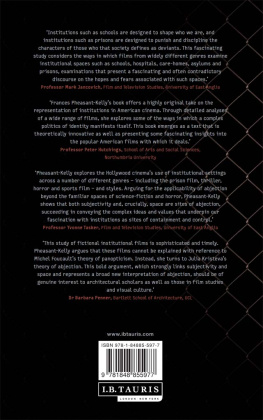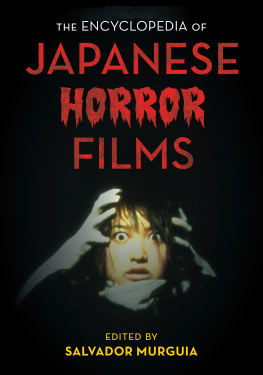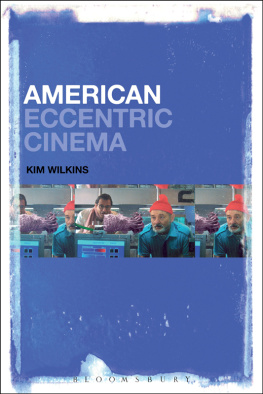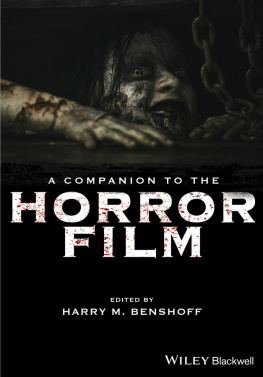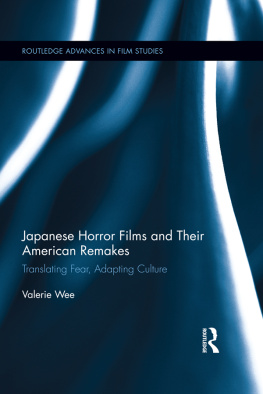Frances Pheasant-Kelly is Senior Lecturer in Film Studies and Course Leader for the MA in Film Studies at the University of Wolverhampton. She holds a PhD in Film Studies from the University of East Anglia and is the author of Fantasy Film Post-9/11 (2013).

Published in 2013 by I.B.Tauris & Co Ltd
6 Salem Road, London W2 4BU
175 Fifth Avenue, New York NY 10010
www.ibtauris.com
Distributed in the United States and Canada Exclusively by Palgrave Macmillan, 175 Fifth Avenue, New York, NY 10010
Copyright 2013 F. E. Pheasant-Kelly
The rights of F. E. Pheasant-Kelly to be identified as the author of this work has been asserted by the author in accordance with the Copyright, Designs and Patents Act 1988.
All rights reserved. Except for brief quotations in a review, this book, or any part thereof, may not be reproduced, stored in or introduced into a retrieval system, or transmitted, in any form or by any means, electronic, mechanical, photocopying, recording or otherwise, without the prior written permission of the publisher.
International Library of Cultural Studies 18
ISBN: 978 1 84885 597 7
eISBN: 978 0 85773 367 2
A full CIP record for this book is available from the British Library
A full CIP record for this book is available from the Library of Congress
Library of Congress catalog card: available
Camera-ready copy edited and supplied by
Oxford Publishing Services, Oxford
Acronyms and Abbreviations
BFI | British Film Institute |
CCTV | closed circuit television |
ECT | electroconvulsive therapy |
EEG | electroencephalogram |
ICU | intensive care unit |
IMDb | Internet Movie Database |
JFK | John F. Kennedy |
OR8 | operating theatre in Coma |
SAIS | School of Advanced International Studies |
USMC | United States Marine Corps |
Acknowledgements
I am grateful to a number of people who have helped in the production of this book. I am especially indebted to Mark Jancovich for his inspiration and encouragement. In addition, my thanks go to the University of Wolverhampton for its extensive support. In particular, I wish to thank my Film Studies colleagues, Eleanor Andrews, Stella Hockenhull, Ken Page, and Pritpal Sembi for their helpful advice. Thanks also go to Michael Kelly for his support and to Lance Hanson and Scott Martin for their valuable insights. I am particularly grateful to Jason and Selina Cohen for their invaluable editing assistance. Finally, my sincere thanks go to Jenna Steventon and the team at I.B.Tauris, especially Maria Marsh.
List of Figures
Introduction: Institutions, Abjection and Subjectivity
Fictional films set in institutions invariably feature scenes of violence, suicide, cruelty or escape, which seems inconsistent with the usual orderliness of real life institutions. Inevitably, however, the excessive control that pervades the on-screen institute leads to visual chaos and narrative disruption. These traits seem universal to the American institution film, the institution film being, for the purposes of this book, one in which the institution is central to narrative organization. Indeed, such patterns of transgression appear regularly throughout the genres well-established history, especially in films set in asylums and prisons. It is therefore relevant to diverge from typical Foucauldian analyses of the institution, which tend to focus on order, regulation and panoptic modes of surveillance, to a theoretical model that centres on the implications of repression. Julia Kristevas theory of abjection provides such a model, which I utilize in this book to explain how fictional institutions order space. Since this approach challenges Foucauldian perspectives, I also consider any tensions that arise between these two apparently opposing viewpoints.
In general, the chaos that emerges in fictional institutions is a consequence of attempts to regulate socially, remould, or break the identity of the inmate. Sometimes this is achieved through seemingly innocuous regimes of drug administration, or often through more radical measures that may involve overt brutality, extended solitary confinement (the hole features regularly in prison narratives) or intrusive surveillance. These aspects are important in providing narrative interest to what would otherwise be mundane and highly repetitive scenarios, though at times they may reflect the practices of real institutions.
In many ways, the filmic institution assumes a parental role, controlling not only the physical body through drugs and prescribed body movement, but also returning the inmate to an essentially infantile psychosexual state. This results from restrictions to conversation, limitations to private space or enforced uniformity of clothing (or even a lack of clothing). Frequently, it stems from the repression of sexual desire. Such suppression of individuality usually leads to inmate resistance and efforts to break away from the institution. Therefore, the institutions highly repressive and regulated spaces are prone to rupture, with any compromise to identity generally leading to efforts to reclaim it.
These characteristics are typically found in One Flew Over the Cuckoos Nest (1975) directed by Milos Forman, a film that sees its protagonist, Randle McMurphy (Jack Nicholson), a psychiatric inpatient, undergo electroconvulsive therapy (ECT) for no apparent good reason. In fact, Head Nurse Ratched (Louise Fletcher) implements this therapy merely because McMurphy resists her cruel, controlling practices, causing McMurphy to suffer irreversible brain damage. As an act of compassion, Chief Bromden (Will Sampson), a friend and fellow patient, suffocates McMurphy, breaks down the window of the asylum and escapes. His escape signals the culmination of many years of repression within the asylum under the dominating rule of Nurse Ratched. This repression is largely attributable to her inflexible and controlling regime, which she achieves through the administration of various alleged forms of treatment such as group therapy, medication and ECT. Ratched further exercises her power through the oppressive surveillance of the patients, but also operates at a more subversive level, regulating their privileges, repressing their libido through drugs and generally suppressing all aspects of individuality. As a result, the patients exhibit infantile characteristics, suggested through various aspects of the mise-en-scne. They are often seen wearing only white underwear, are susceptible to frequent tantrums, and their physical stature and behaviour, especially of Martini (Danny DeVito) and Cheswick (Sydney Lassick), are childlike. Their infantilism is also represented through problems mastering speech; Chief Bromden is apparently deaf and dumb and Billy Bibbitt (Brad Dourif) speaks with a pronounced stutter, while the rest of the group seem mostly reluctant to say anything during group therapy sessions.
Ratched manifests as a monstrous version of femininity, signified visually by her twin-horned hairstyle and cold, unblinking eyes. Indeed, in the spectators first visual encounter with Ratched, she appears in a flowing black cape and black hat. In marked contrast, McMurphy, who resists her controlling practices, seems humane and compassionate and, despite being a convicted rapist, easily gains the spectators sympathies. He remains the sole figure of adult masculinity on the ward, suggested by the fact that he is the only patient to wear his own clothes, a typical means of expressing an individual, gendered identity. His masculinity is also emphasized physically (he escapes by scaling a high barrier), and he has been incarcerated because, as he claims, [he] fight[s] and fuck[s] too much. Indeed, he becomes a father figure to the other patients and encourages them to engage in experiences that develop their masculine egos. McMurphy is not merely the good father but becomes almost a Christ-like figure, helping the patients overcome their various social inadequacies. Although Ratcheds efforts to control McMurphy and repress his sexuality repeatedly fail, she still exerts a strong influence over the other patients, particularly Billy Bibbitt.
Next page
